Ultimate Honda K24 Guide – Everything You Need To Know
The Honda K24 is an underrated powerhouse and a popular choice for engine swaps, combining impressive tuning potential with legendary reliability.
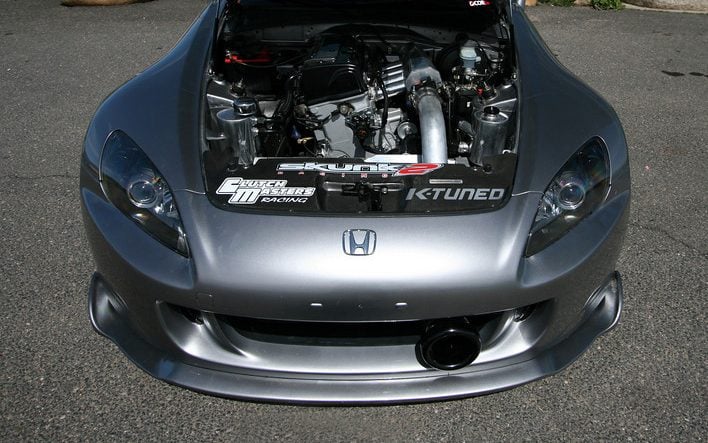
You can quickly navigate to a specific section or scroll past to learn everything about the Honda K24 engine.
Jump To Section
Honda K24 Introduction
Honda is often ridiculed for being the “ricer” brand in the drift community. However, we can’t ignore its undeniably impressive impact on the automotive landscape.
Don’t forget – they brought us the NSX and the S2K!
If you look beyond the badge, we’re sure that most drifting fans will agree that Honda’s K-series engines are immensely underrated. (Assuming they know a thing or two!)
However, if you’re still huffing and puffing about FWD rice boxes, we recommend our previous guide for the K24’s younger brother, the Honda K20.
*WARNING* That guide contains RX7 FDs fitted with Honda powerplants! Too late? Whoops. (Sorry, not sorry!)
A Legendary Lineage
Honda’s K24 series has birthed several immensely popular engines over the years, and there have been more updates and variations than most enthusiasts realize.
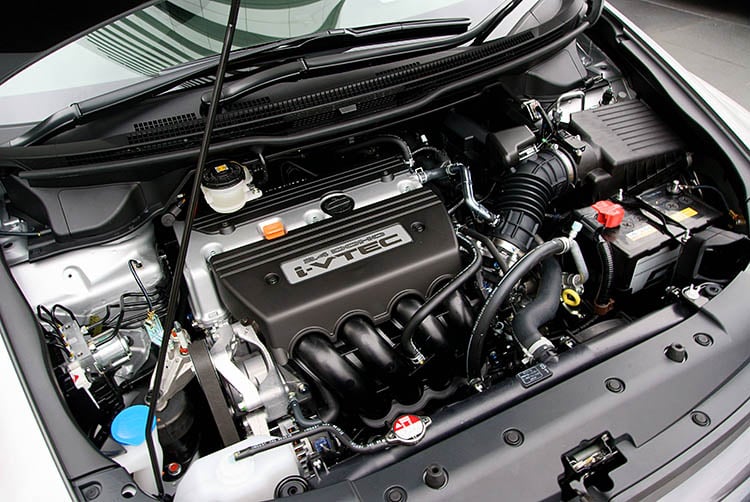
The K24’s design is similar to that of its predecessor, the 2-liter K20. However, it features a larger displacement (2.4L vs. 2.0L) and produces more torque.
After its launch in 2001, the 2.4-liter K24 debuted in the Honda CR-V with the original K24A1 variation.
Throughout its lifespan, the K24 introduced several advancements, such as friction-reducing technology and electronically controlled ignition timing.
Production continued until 2022 with the most recent K24W7 and K24V7 “Earth Dreams” variants. But most enthusiasts aren’t after these economy-focused variants.
As with most modern engines, the recent focus turned more towards emissions and efficiency than on the initial, more performance-oriented focus.
For this reason, earlier engines remain the most desirable for those with hunting tuning potential.
Later, we’ll explore what changed between the many Honda K24 variations.
The Beauty Of The K24
Beyond the benefits that Honda owners know well, one of the best things about Honda’s K-series is its convenience when swapping it into some of the least likely chassis.
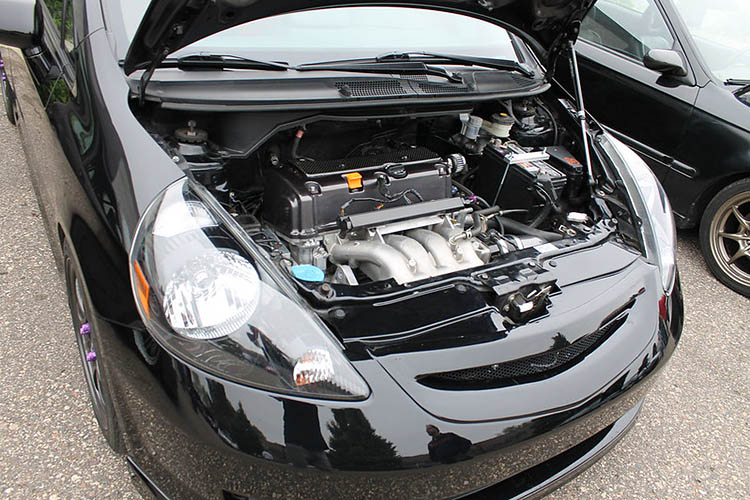
We’d forgive you for thinking purely of cheap, FWD cars. But you may be surprised to hear that swapping the K24 into just about any chassis is often a fairly convenient swap (in the grand scheme of things), even with some rarer mid-engined offerings.
V8 swaps have become increasingly common throughout various motorsport disciplines, mostly thanks to their reasonable price tags and the convenience of sourcing parts and replacement engines.
Of course, it’s also down to their impressive reliability, power potential, and ability to handle forced induction efficiently.
But what if we told you that the Honda K24 also ticks all these boxes?
Also, don’t forget the legendary Variable Valve Timing and Lift Electronic Control system, more commonly known as VTEC (just kicked in, yo!).
This system adjusts valve timing and lift to optimize performance across the RPM range and is explained in-depth in the video below:
There’s heaps to uncover here, so we’re breaking it into clear sections. You can scroll down to see what’s on offer or head to the top of the page to navigate to a specific section.
Honda K24 Tuning
Let’s start with the tuning potential.
We’ve seen plenty of highly-tuned Honda K24s over the years, and “affordable” and “performance” are two words that we feel perfectly describe the engine. You could also throw “reliable” into the mix!
Tuning the K24 engine offers a wide variety of options, and it can produce incredible power figures if you’re willing to invest the time and money to unleash its potential.
As always, you’ll likely need to include some blood, sweat, tears, (and plenty of swearing), but it’ll likely be worth it!
You’ll likely already know that the holy grail K24A2 is the most popular choice, with the ability to achieve 205 hp and 164 ft/lb torque out of the factory with the Acura TSX, but what if we want to aim higher?
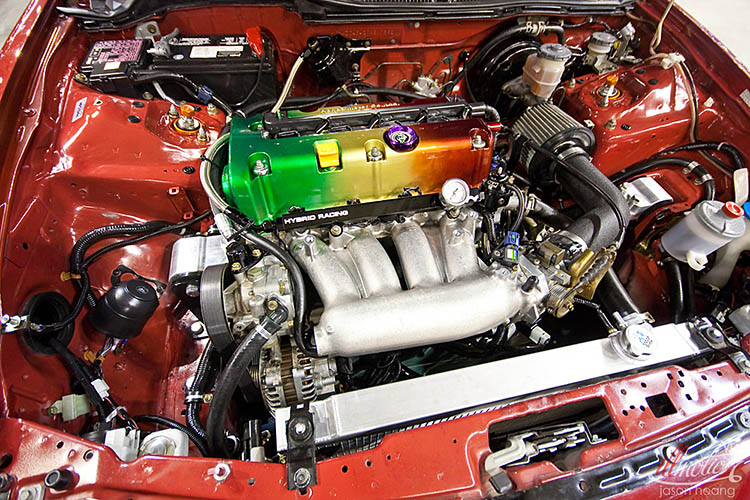
The general recommendation to get the best basic setup with the K24 is to buy any K24A cylinder block, along with a K20A2, K20A Euro R, or KA20A Type R head.
This is typically known as a “Frankenstein” or “K20/K24 Frankenstein” motor, which you’ve likely already heard of if you’ve made it this far.
Be warned that this only applies to the K24A series engines. The K24Z* engines cannot be used because the pistons make contact with the K20s cylinder head.
Although it may seem odd to use K20 parts, they feature superior valve springs and camshafts to the K24. If you opt for this route, you’ll also want to consider replacing the K24 water pump with the one found in the K20.
With race bearings, high-compression pistons, rods, studs, an uprated flywheel, fuel injectors, an ECU upgrade, and a K20A2 oil pump, you’re likely to get about 260 horsepower.
Suppose that’s not enough, and you want to go to 300hp without considering the forced induction route. You can consider additional internal porting, valves, cams, an upgraded throttle body, a CAI, upgraded manifolds, and a full exhaust system.
Forced Induction & K24 Crate Engine Options
If you’re willing to go down the forced induction route, power figures start at around 400 hp and rise to some pretty incredible numbers (800+ horsepower) if you have the cash to throw at it.
Are you considering building a 500-horsepower K24 engine? This video will show you how it can be done. (Okay, perfectionists, it’s more of a K27, but you get the idea.)
If you have the cash and want the ultimate option, there are various K24 crate engines for sale.
Companies such as 4 Piston Racing offer highly-tuned turn-key K24 crate engines, with their K340 offering 340hp at 9,000 RPM, right through to their full drag setup, capable of an insane 8.94-second quarter-mile.
Sounds perfect, right? Sure, but be prepared to pay the price! 4 Piston Racing will happily sell you one for around $12,000.
The great thing about the K24 engines is the wide variety of modifications on offer, whether you’re looking for some off-the-shelf power upgrades or a full race engine build.
They’re certainly capable of producing incredible power figures with extremely high levels of reliability when built and maintained correctly. It’s a Honda, after all!
They can also make for perfect drift car engines. Need proof? Make sure you turn up the volume and prepare for an eargasm as we head back to 2014 to appreciate this S2000 K24 Formula Drift build:
Honda K24 Engine Swaps
Okay, this is where things get fun. We’ve all seen the Civic EG K24 swaps, and yeah, they’re convenient, but let’s face it, everyone and their dog has done that by now.
Over the years, we’ve seen some pretty wild K24 swaps, from Honda NSXs to bespoke Noble M400s.
This proves what we said earlier about the Honda K24 being the perfect V8 rival for almost anything, from RWD drift cars to mid-engine Time Attack weapons.
A simple Google search will reveal just how many simple K20/K24 swaps are available on the market, and several off-the-shelf packages are available for Mazda Miata and Nissan 240SX owners.
For those of you considering it for your 240SX or Miata, the most common transmission for the swap would be the BMW ZF manual gearbox, which is easily sourced and reasonably priced. (Well, drift tax considered!)
Other common K24 conversions are the Civic, the Toyota MR2, various Lotus models, and (of course) the Honda S2000.
Let’s start our crazy swap list with this ridiculous Subaru BRZ! BRZ + K24 + gigantic turbo = this 700 hp insanity:
Since we mentioned mid-engined cars, how about another turbo-powered K24, this time in an MR2?
If MR2s aren’t your thing, you can surely appreciate a Supercharged 700 hp, 800 kg Lotus Exige turbo K24 destroying the competition at a Hillclimb event?
Or, what about the perfect sleeper? This Indonesian dude has the perfect recipe with his Honda Brio!
Finally, it doesn’t get much more awesome than this. This wheelie-popping K24-powered Toyota Tacoma destroys the competition at a drag event to collect $5,000. Just a couple more events and he can get a spare crate engine!
K24 Vs LS Swap
We often get asked whether the K24 or the LS is the better option.
A wide range of K24 engines are found under the hood of popular everyday cars, including the Honda Accord and CR-V. This makes them extremely convenient and cheap to source.
In addition, the K24 is impressive for off-the-shelf upgrades and aftermarket support. Swapping in a K24 could be ideal for enthusiasts looking for high-power potential (800+ hp with upgraded internals).
With an ever-increasing off-the-shelf aftermarket mounting and wiring options available, it’s emerged as an underdog in the engine-swap world over the years.
As the popularity of LS swaps increases, the K-series continues to prove itself as so many drifters opt for the typical V8 route.
Whether you’re looking for a cheap and reliable daily driver swap or a fully boosted race setup that’ll get you sideways or smash quarter-mile records, the K24 should be a contender.
However, if you’ve got enough cash to throw at your build and want huge power figures, LS is typically the way to go.
Here’s how they stack up head-to-head:
| K24 Swap | LS Swap | |
|---|---|---|
| Availability | Widely available in Honda/Acura vehicles (or crate options) | Easily sourced in various GM vehicles (or crate options) |
| Cost | Generally cheaper (around $6k for 260hp N/A setup) | More expensive (around $15-16k) |
| Power Potential | 160-200 hp stock (800+ hp modified) | 300-682 hp stock (1,000 hp+ modified) |
| Torque | Lower torque, especially at low RPMs | High torque across the RPM range |
| Weight | Lighter (various weights) | Heavier (various weights) |
| Aftermarket Support | Extensive, growing popularity | Vast, well-established |
| Reliability | Honda’s typical highly-regarded reliability | Generally reliable, especially stock |
| Fitment | More room in the engine bay, easier maintenance | Tighter fit (may require more modifications) |
| Exhaust Note | High-revving 4-cylinder sound | Classic V8 rumble |
| Tuning | Typically requires more work for higher power | Easier to achieve high power |
| Uniqueness | Less common, standing out in drift scene | One of the most common swaps |
Speed Academy also compared them in this video, which is well worth a watch:
Honda K24 Forced Induction
If you plan to feed your K24 with some sweet, performance-inducing forced induction, there are plenty of choices on the market.
There’s certainly no shortage of turbocharged K24s, but there are also a decent number of supercharged ones.
Thankfully, the K24 is one of the most convenient engines when it comes to forced induction and can be one of the cheapest and most convenient engines to modify.
With the stock internals handling up to 4-500hp, you can see why so many people opt for the K24 when it comes to engine swaps.
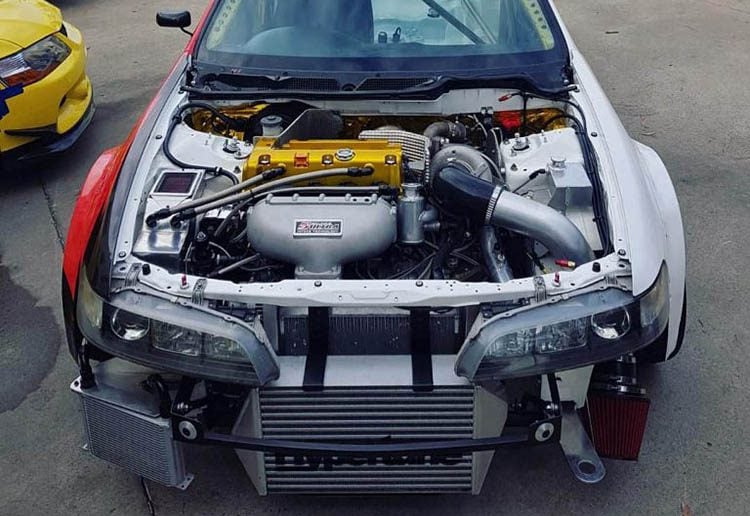
That said, forced induction does, of course, put a lot of strain on any engine, especially older ones that have perhaps not been fantastically well-cared for.
Therefore, we’d always do a thorough tear-down to ensure you have a solid base before you potentially have to find out the hard way.
We’d also consider upgrading the internals to prevent the inevitable tears when you start bouncing off the limiter later!
If you’re unsure whether you’d prefer to go down the turbocharger or supercharger route, we can help! Our turbocharger vs. supercharger article answers all the questions likely rattling around in your brain.
Honda K24 Reliability & Common Issues
The K-series is a true testament to Honda’s reliability, and a well-maintained stock engine is likely to last you hundreds of thousands of miles with minimal maintenance.
However, since you’re at Drifted, the chances of opting for the stock route are slim. For many, the well-maintained aspect could be lacking a little, too. (Not that we’re not pointing any fingers!)
Although the engine is extremely robust and durable, it does have some minor niggles, as just about every engine we’ve ever taken a look at would.
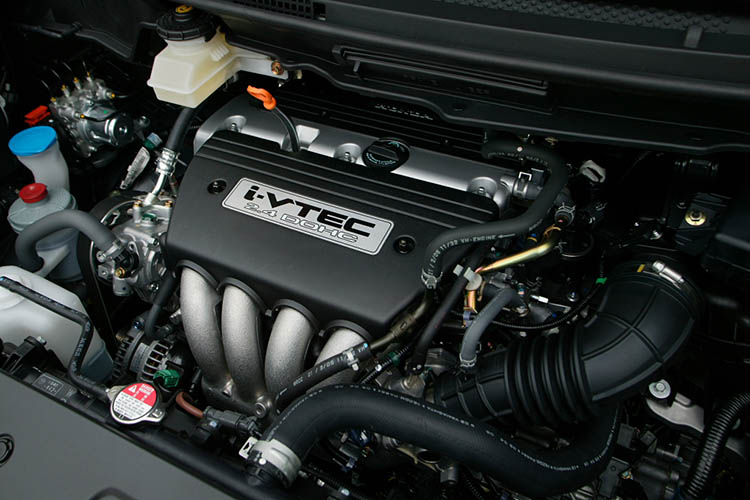
One of the main components to fail can be the timing chain sensor, but there are solutions to minimize the risk.
In addition, the tensioners on the timing chain are known to go bad, too. If this happens, you are looking at a repair bill in the neighborhood of $700 to $1200. A small price for JDM supremacy, I would say! *wink*
There are occasionally issues with leaking oil seals and excessive wear on the exhaust camshaft.
Rough engine noises can often be attributed to the incorrect use of engine oil or a lack of maintenance. Lack of upkeep has also been the leading cause of rattling timing chains.
Over time, this can deteriorate the VTC gear, which would likely need replacing, especially if it comes from the engine’s right side.
It has to be said – these are mostly minor niggles, and almost always come down to improper maintenance.
So, keep up with your servicing and don’t go crazy with modifying *cough*. If you do, a K24 engine will likely last at least 200,000-300,000 miles.
Honda K24 Engine Specifications
We will break down the differences since there are so many options in the Honda K24 lineup.
This will help you choose the best K-Series engine for your specific needs, whether building a drift car, drag car, autocross champ, or just for a daily/show car.
In addition, we’ll also cover the main positives and negatives of the commonly found versions.
K24A1
The K24A1 was Honda’s first engine within the K24 range. It was featured in the 2002-09 Honda CR-V and had 160 hp and 162 lb-ft torque.
It was a very similar engine to the B-series, with impressive low-end torque production.
Although it offers respectable performance, its compression ratio is 9.6:1, lower than some other K24 variants, affecting its performance potential.
The K24’s predecessor, the 2.0-liter K20, featured more durable connecting rods and superior counter-weighted crankshafts. However, the K24A1’s larger displacement provides superior torque.
This allowed for superior power and torque when combined with the more significant displacement and the addition of a composite two-stage intake manifold.
It’s worth noting that the K24A1 has no VTEC mechanism on the exhaust cam and mostly relies on twelve valves before 2,200 RPM, with the other four coming into action after. This i-VTEC (intelligent VTEC) system controls valve activation based on RPM.
The K24A1 has become one of the most popular engine swaps and conversion choices due to its availability, relatively low cost, and potential for modification.
Thanks to the similarities between the A1 and A2, you can straight-swap the A2’s oil pump, which isn’t possible on other K-series engines. This allows for improved oil flow and potential performance gains.
The K24A1 has one of the best cylinder heads. It takes kindly to being ported, allowing for impressive airflow. When properly ported, these heads can produce over 300 CFM, rivaling some aftermarket options.
Alternatively, if you’re looking for a convenient swap, the RSX Type-S head from 2002 to 2006 (PRB cylinder head) is also an option but is highly sought-after. This flows at 299 CFM, making it the highest-flowing stock head available in the US.
The K24A1 can gain approximately 30-50 horsepower over stock with bolt-on mods (intake, exhaust, and ECU tuning), bringing the total output to around 190-210 hp.
If you’re looking for the best out-of-the-box solution from the K24, then let us introduce you to the K24A2. This variant is the highest regarded in the lineup since it offers higher stock performance and even greater tuning potential.
K24A2
The K24A2 is considered the most impressive K24 engine, but its popularity has led to higher prices, making other variants more attractive if you’re not shy when it comes to tuning.
It is featured in the Acura TSX, Honda Odyssey Absolute, and JDM Honda Accord Type-S and produces between 197-205 hp and 164-171 lb-ft torque.
The A2 was also known as the K24A3 in the European and Australian markets.
Honda significantly updated the bottom end for the A2, increasing the compression ratio to 10.5:1. The engine block features dual balance shafts, a forged crankshaft, reinforced connecting rods, and lightweight pistons.
Unlike the K24A1, the K24A2 utilizes the i-VTEC system on both the intake and exhaust camshafts. The full performance i-VTEC system kicks in after 6,000 RPM.
For the 2006-onwards Acura TSX, Honda further improved the K24A2 with the following:
- Enlarged air intake duct (70mm to 80mm)
- Upgraded throttle body (60mm to 64mm)
- Enhanced intake valves (increased to 36mm)
- A new intake camshaft
- Exhaust upgrade (2.25″)
These improvements improved the K24A2’s peak performance, producing 205 horsepower and 164 lb-ft torque.
However, with these enhancements, the horsepower output increased from 197 to 205 hp, but the torque slightly decreased from 171 to 164 lb-ft.
The K24A2 responds exceptionally well to mods, and with basic bolt-ons and a reflash, you can expect around 230-240 horsepower.
K24A3
The K24A3 is the European and Australian market equivalent of the K24A2, featured in the Honda Accord and Accord Euro models from 2003 to 2007.
The A3’s output is 190 hp and 164.5 lb-ft of torque. It features the same 10.5:1 compression ratio as the K24A2, with VTEC kicking in at 6,000 RPM before hitting the redline at 7,000-7,200 RPM.
Unlike the K24A2, the K24A3 didn’t receive upgrades in its later model years, so the performance figures stayed the same throughout the production run.
With the usual basic bolt-on modifications (intake, exhaust, ECU tuning), you can expect around 20-30 horsepower over stock, bringing the total output to around 210-220 hp.
K24A4
The K24A4 block is often the most common choice for those planning on swapping out the pistons. Thanks to its popularity, it can be sourced for a reasonable price.
The A4 is based on the A1 rather than the A2 and features a 9.7:1 compression ratio.
For power, you get 160 hp and 161 lb-ft torque, and it’s found in the Honda Accord (2003-2005), Honda Odyssey (2003-2008), and Honda Element (2003-2006).
Several revisions include an RAA single-stage intake manifold and revised intake and exhaust ports inside the cylinder head, which most enthusiasts agree don’t flow as well as the A1.
The primary purpose of the K24A4 was to meet stricter emissions standards at the time. Since the power barely differs from the A1, Honda did a decent job balancing emissions compliance with performance.
With basic bolt-on upgrades (intake, exhaust, and ECU tuning), you can expect to gain around 15-20 horsepower.
K24A8
The K24A8 is a refined version of the K24 engine, introduced in 2006 to meet updated environmental regulations. It powers the Honda Element, Accord, and Odyssey.
The A8 features minor changes from its predecessor, including:
- A RAA intake manifold
- An electronic throttle body
Its power output also varies slightly, depending on the version:
- Honda Accord (2006-2007) – 166 hp and 160 lb-ft
- Honda Element (2007-2011) – 166 hp and 161 lb-ft
- Honda Odyssey (JDM, 2008-2014) – 178 hp and 161 lb-ft
It maintains a compression ratio of 9.7:1 and has a redline of 6,500 RPM in the Accord, with a slightly higher 6,800 RPM redline in the Element.
These improvements help the K24A8 balance performance and emissions, designed mostly for Honda’s family-oriented vehicles.
With basic bolt-on modifications (intake, exhaust, and ECU tuning), the K24A8 can gain approximately 15-25 horsepower over stock.
K24Z1
Launched in 2007 for the Honda CR-V, the K24Z1 officially replaced the K24A1.
The K24Z family aimed to meet the ever-growing emissions standards while still trying to build on the success of the K24A.
It maintains the 9.7:1 compression ratio and delivers 166 hp and 161 lb-ft torque, with a redline of 6,500 RPM.
The oil filter is relocated for this version, and internal changes include a forged steel crankshaft and an internal balancer unit.
Honda continues to use the later 1-stage RTB intake manifold alongside an electronic drive-by-wire throttle body.
A new, denser catalytic converter was also introduced to comply with the increasingly harsh emissions standards.
Despite its environmental focus, the K24Z1 remains a solid foundation for tuners.
With the right aftermarket parts and proper tuning, the Z1 is still capable of impressive figures. With the usual bolt-on mods, you can expect an additional 15-25 horsepower.
However, as we’ll look at in the next section, the K24Z engines are unsuitable for “Frankenstein” builds.
K24Z2
The K24Z2 officially replaced the K24A8 on the production line and conformed to the highest emission standards.
Its 10.5:1 compression ratio, revised fuel injectors, integrated exhaust manifold, and R40 intake manifold enabled power figures of 177 hp and 161 lb/ft torque, and basic bolt-ons (intake, exhaust, tune) can add 15-20 hp.
While it’s not as tuner-friendly as the earlier K24 variants, it’s capable of respectable gains.
K24Z3/K24Z7
The K24 received a significant overhaul with the K24Z3 engine, which arrived with the second-generation Acura TSX.
Early versions (also found in the Accord) had 190 hp and 162 lb-ft torque.
However, the 2009-14 Acura TSX received an improved version with 31mm exhaust valves and a modified i-VTEC system that engages at 5,100 RPM.
This provides a compression ratio of 11.0:1, increasing output to 201 hp and 172 lb-ft torque.
The CP2 and CS1 Honda Accord models feature the TSX’s superior engine, essentially the same as the K24Z7.
Key features include chain-driven dual balance shafts, i-VTEC on both intake and exhaust camshafts, lightweight alloy pistons, high-strength connecting rods, and computer-programmed fuel injection (PGM-FI). The engine also utilizes a high-flow stainless steel exhaust manifold.
The K24Z7, used in the Honda Civic Si and Acura ILX from 2012-2015, produces 201-205 hp and 170-174 lb-ft.
K24Z4/K24Z5/K24Z6
Honda’s K24Z4 replaced the K24Z1 to meet stricter emissions standards. It maintains a 9.7:1 compression ratio, producing 161 hp and 161 lb-ft torque.
Both the K24Z5 and K24Z6 are similar to the K24Z2 with minor differences. The K24Z5 was exclusively available in the Chinese market, while the K24Z6 was offered in the 2010-2014 Honda CR-V models sold in the United States.
The K24Z6 produces more power than the Z4 variant, delivering 180-185 hp and 161-163 lb-ft torque. This makes it one of the more powerful engines in the Z-series lineup, despite still focusing on emissions.
Which Cars Have the Honda K24 Engine?
Many changes have been made to the K24 engine over its lifetime.
We highly recommend reading on if you’re considering which variations are best for your needs, particularly if you want to tap into its tuning potential.
Here is a list of the many cars powered by the Honda K24 series from the factory:
K24A1
2002-2006 Honda CR-V
K24A2
2002-2008 Honda Accord Type-S (Japan)
2003-2008 Honda Odyssey Absolute
2004-2008 Acura TSX
K24A3
2003-2007 Honda Accord (Japan/Europe)
2003-2007 Honda Accord Euro (Australia/New Zealand)
K24A4
2003-2005 Honda Accord (U.S.)
2003-2008 Honda Odyssey
2003-2006 Honda Element
K24A8
2006-2007 Honda Accord (U.S.)
2007-2011 Honda Element
2008-2014 Honda Odyssey (Japan)
K24W (Earth Dreams)
2013-2017 Honda Accord (U.S.)
2015-2019 Honda CR-V (U.S.)
K24W4
2013-2018 Honda Accord (Thailand/Malaysia)
2014-2018 Honda Odyssey (Australia)
K24V5
2017-2022 Honda CR-V (Thailand)
K24V7
2016-2022 Acura ILX
K24W7
2015-2020 Acura TLX
K24Y1
2012-2016 Honda CR-V (Thailand)
K24Y2
2012-2015 Honda Crosstour
K24Z1
2007-2009 Honda CR-V (RE3, RE4)
K24Z2
2008-2012 Honda Accord LX/LX-P (U.S.)
2016-2020 Proton Perdana
K24Z3
2008-2012 Honda Accord LX-S/EX/EX-L (U.S.)
2009-2014 Acura TSX
2008-2015 Honda Accord (CP2, CS1)
K24Z4
2008-2012 Honda CR-V (RE7)
K24Z5
2010-2015 Honda Spirior
K24Z6
2010-2011 Honda CR-V (U.S.)
2012-2014 Honda CR-V (U.S.)
K24Z7
2012-2015 Honda Civic Si
2013-2015 Acura ILX
Honda K24 Final Thoughts
Hondas don’t always have the most favorable reputation within the tuning scene, but the K24 and the K20 deserve a lot of respect. We think there’s a good chance we may see even more of them in the drift scene in the years to come.
If that’s the case, we’re not complaining!
Honda’s K-series engines are certainly one of the best value-for-money choices out there.
We’ve compared them to V8s several times in this guide, but we find them even more tempting in some ways.
V8s have often had a tough life. Due to their popularity in the motorsport world, they’re also suffering from ever-increasing inflation (much more than the K24), and many are certainly showing signs of age (unless you can get a crate engine!)
Oh, and did we mention the ever-growing fuel costs?
We’re not saying that every K24 has had an easy life, but we’d bet that Grandma hasn’t been doing quite as many burnouts in her Accord.
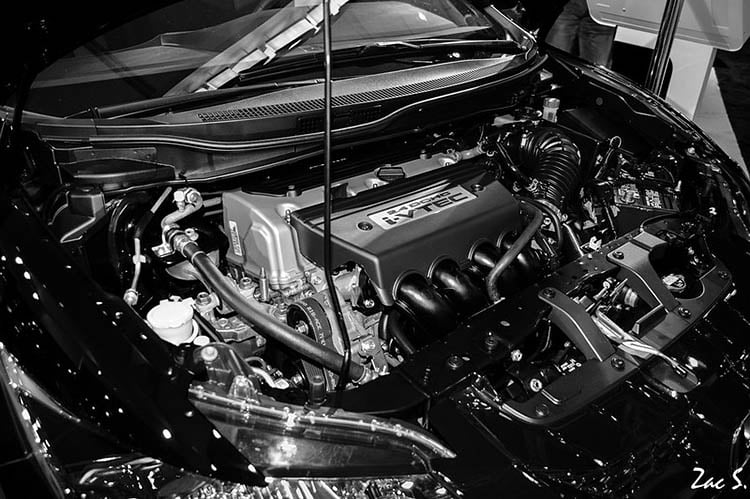
If you’re looking for the best K24 engine right out of the box, the K24A2 is the perfect choice.
However, given the convenience of upgrades, modifications, and matching parts between the various K-series engines, we certainly wouldn’t stress too much about ensuring we got the A2.
The obvious desirability has caused prices to skyrocket compared to the less sought-after versions.
Given how conveniently almost all of the K24s take to forced induction, they certainly have to be considered for those looking to go down that route.
The BMW gearbox conversion is also an extremely convenient swap for RWD cars and even more so for mid-engine cars. This stunning 1,000-horsepower K-swapped NSX is a perfect example:
We hope this guide has covered everything you need to know about the fantastic Honda K24 engine.
If you’re not entirely sold on the Honda K24 just yet, make sure you also check out our Honda K20 guide to help you decide. You should also check out our Honda B16 and D16 guides.
If you’re also interested in Honda’s other engines, check out our comprehensive Honda B-Series guide.
Those who want to drift Hondas without the price tag can do so completely free in Drift Hunters MAX. Also, keep your eyes peeled for the upcoming Forza Horizon 6 game, as plenty of Hondas will be available!
Thank you for reading our Honda K24 guide
If you enjoyed this article, please share it with the buttons at the side and bottom of your screen. If you’ve found the information useful, please take a moment to share it with other Honda or engine swap enthusiasts. We appreciate your support.
Photography credits
We thank the following entities for the use of their photography in this article:
- kevos2k on S2KI
- Reece Mikkelson on Flickr
- Jason Hoang on Flickr
- Zac Shee on Flickr
- Tennen-Gas on Wikimedia Commons
- Hatsukari715 on Wikipedia
- Engine Swap Depot


 (22 votes, average: 4.73 out of 5)
(22 votes, average: 4.73 out of 5)




















